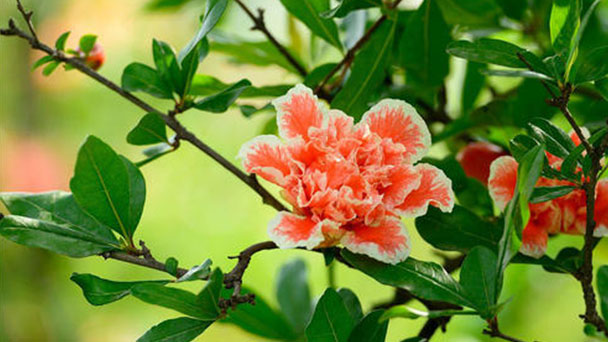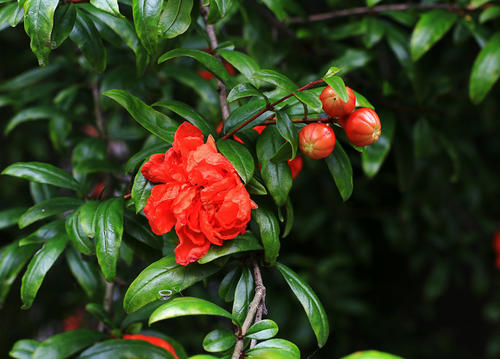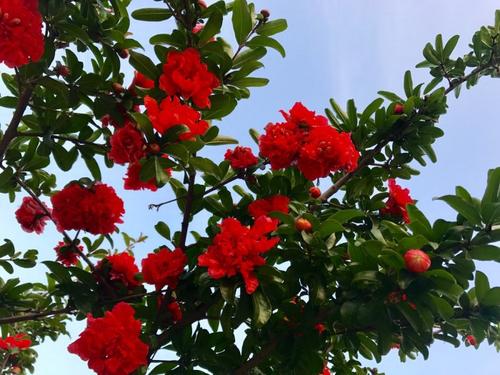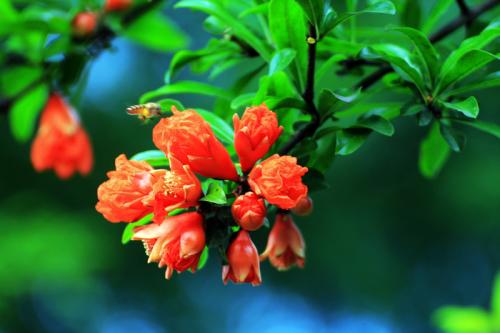How to grow and care for Pomegranate flowers
Written by Maggie
Jan 11 2021

Pomegranate flowers mean mature beauty, wealth and a family full of descendants. The bright red Pomegranate flowers are also widely loved by everyone. Many plant farming enthusiasts are interested in Pomegranate flowers. Then how to grow Pomegranate flowers? How to care for Pomegranate flowers when we grow it? Please read with me the growing methods of Pomegranate flowers and Pomegranate flowers care!

Growing methods of Pomegranate flowers
Best growing time: pomegranate flowers can bloom for a long time from May. Biennial branches in spring or semi-lignified branches in summer can be used for cutting, and root 15 to 20 days after planting.
The best growing soil: Pomegranate Flowers is not strict with the soil requirements, with fertile, loose and nutritious sandy loam soil is the best.
Growth humidity requirements: Pomegranate flowers should be controlled watering, should be dry rather than wet.
The best growing temperature: Pomegranate flowers are hardy and need to overwinter in a low-temperature room, above 2℃.
Optimum growing light: Pomegranate flowers like sunny and are resistant to high temperature plants. Therefore, for garden or balcony pots Pomegranate flowers do not need shade. In the growing season, there should be sufficient sunlight; In summer it can be placed under the scorching sun, basking in flowers more colourful, fruit more.
Pomegranate flowers care
Fertilizeing care
Fertilizer should be applied after germination of potted Pomegranate flowers. Generally, dilute organic fertilizer liquid should be applied. Apply 0.2 {BF} urea solution once every 10 days and twice from May to June.In the later period of fruit growth, two times of 0.3 {BF} potassium dihydrogen phosphate solution should be applied in addition to organic fertilizer. In the growing period, we should pay attention to the weather conditions. When the temperature is high, the weather is sunny, the basin soil after drying timely watering. Flowering watering should be careful not to pour on the flowers, so as not to affect fruit setting, in addition to rainy flowering should take shelter measures.

Watering care
Pomegranate flowers require moist soil, but they are not resistant to waterlogging. Therefore, regardless of the ground or pot, both often keep the soil moist, and can not waterlogging. In summer, water is generally 1 time a day, and in late autumn water can be poured 1 time a day. Potted Pomegranate flowers in the flowering and bearing period to strictly control watering, avoid by all means to see the basin soil surface dry immediately watering. We might as well wait for its branches and leaves slightly wilting, then watering is not late, and pouring must be watered through. If the basin soil is too dry, easy to cause falling buds, dried fruit and fruit drop; The basin soil is too wet, although sometimes does not affect the growth of the plant, but also easy to appear the phenomenon of falling bud and cracking fruit. This is also one of the factors that affects its flowering and bearing.
Pruning care
Mixed buds grow at or near the top of strong, short shoots. These should be kept during dormant pruning, without cutting or thinning. Long branches in the pruning can retain the base of 2 ~ 3 heavy short bud, germination conditions after the year can grow fruit mother branches.
Pot soil replacement
For potted Pomegranate flowers, on the basin or in the basin, the bottom of the basin plays foot base fertilizer. Fertilizer can be composted or cooked chicken, duck dung, cake fertilizer.
Propagation points: Commonly used cuttings, splitting and layering propagation. Cuttage, choose biennial branches in spring or semi-lignified branches in summer cuttings can be inserted after 15 ~ 20 days to take root. Separate plant, can be in early spring in April bud initiation, dig robust root tiller seedling points. Slathe, spring, autumn can be carried out, do not have to cut injury, before bud initiation with root part tillering pressure into the soil, after the summer rooting cut from the mother plant, autumn is into seedlings.
Disease and insect control: Mainly leaf blight and gray mold, and can be used 70 {BF} methyl tobutin wettable powder 1000 times liquid spray. Insect pests include moths, scale insects and aphids. Use 55 {bf} to kill borer pine emulsion 1000 times liquid spray.
Pomegranate flowers are abundant and can bloom for a long time from May. The bell-shaped flowers of pomegranate can not set fruit, only part of the tubular flowers can set fruit, bell-shaped flowers account for a large proportion, so before flowering in addition to ornamental needs to keep a part of the bell-shaped flowers, the rest of the bell-shaped flowers can be dried in the bud stage in order to save nutrients (some can be used as anthers for pollen drying). The cylindrical Pomegranate flowers are generally divided into early, middle and late flowering stages.

Latest Updated
- Benefits of Bugleweed - 7 Science-backed Health Benefits
- Bugleweed Dangers & Side Effects - Is It Poisonous?
- How to Plant Evergreen Trees - What You Should Know
- When to Plant Evergreens - Grow Guide for Evergreen Trees
- 12 Wonderful Evergreen Shrubs for Your Garden
- 12 Popular Evergreen Plants with Pictures for Beginners
- When And How To Prune A Lilac Bush Like a Pro
- How to Grow & Care for Lilac Vine (Hardenbergia Violacea)
- Japanese Lilac Tree (Syringa Reticulata) Care & Propagation Guide
- Shumard Oak Pros and Cons - What to Know
Popular Articles
- Winter maintenance of Antirrhinum Majus
- How to Grow Terminalia Mantaly Tree
- How to Grow and Care for Crossostephium Chinense
- How to grow Antirrhinum Majus in spring
- Peristeria Elata (Dove Orchid) Profile: Info & Care Guide
- Underwatered Snake Plant (Sansevieria Trifasciata) - Signs And How To Fix
- How to Care for Brazilian Jasmine Plant (Mandevilla Sanderi)
- How to Grow & Care for Graptopetalum Purple Delight in Summer
- Rosa Chinensis (China Rose): Plant Growing & Care Tips
- How to Care for Baby Sun Rose (Aptenia Cordifolia)